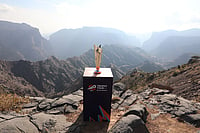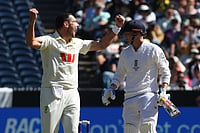Brands surround us every waking moment. From the groggy minute spent brushing our teeth to the switching off, many hours later, of the bedroom light, we live out our days with the help of goods and services whose names, logos and whispered promises have infiltrated our consciousness to the point that we dont even notice. Often the brand becomes the product itself, for instance, when we xerox a document or scotch tape a gift wrapping. Brands give us comfort, offer guarantees of quality and security.
Brands create value. They create value in our minds and we willingly pay more for them than unbranded products or less popular brands that may offer the same core benefits. And for the marketer, brands create value on their bottomlines. In the stockmarkets, brand values influence share price and consequently the perceived value of the company.
Run these numbers. According to a survey of the worlds top brands by research firm Interbrand, the value of the planets No. 1 brand, Coca-Cola, was as much as 59 per cent of the beverages companys $149-billion market capitalisation, that is, the value of all the companys shares. Nike, BMW and Apple, which ranked 28th, 22nd and 36th in the survey, each with 77 per cent of market capitalisation tied to the value of their brands! For Ford (5th), Disney (6th), and McDonalds (8th), the figures are 58, 61 and 64 per cent, respectively.
Millennium-end is, therefore, the perfect time to have a look at great Indian brands.
Outlook asked nine eminent marketing and advertising professionals to give their lists of the greatest Indian brands. Only brands that are owned by Indian companies or created specifically for India by transnational companies were considered. From these lists, we culled the 10 names which appeared the highest number of times to get the 10 greatest Indian brands of this century, and, by inference, of all time.
But how well have Indians been able to create brands? Develop a living entity that has a personality, whose name conveys certain attributes and qualities with which consumers build a relationship? Alyque Padamsee, marketing consultant and former CEO of Ammirati Puris Lintas, likes to narrate the following tale. It happened way back in 1982, the year India hosted the Ninth Asian Games. Advertising legend David Ogilvy was in the Indian capital to address a conference, and compared Asian advertising (read India) to the proverbial tortoise in Aesops fables. "He (Ogilvy) was confident that advertising in this part of the world would one day overtake the Western hare, primarily because global brands from the West would have exhausted their home markets and look for new pastures." But, adds Padamsee, Ogilvys subtle hint was inclined more towards global brands and not Indian.
And why not, asks Padamsee? He calls it a serious problem traditionally ignored by the Indian corporates and also by the Rs 10,000-crore advertising industry. After all, not many Indian companies sustained brand-building efforts and, expectedly, got crushed by global brands which have flooded the market after economic reforms began. "Its a pity that the country does not have many companies whose brands can be seen as truly Indian," says Padamsee. "And why blame companies? For decades, not many agencies have helped their clients understand the importance of brand development," adds the ad guru.
Padamsees views are shared by Tara Sinha, the grand dame of Indian advertising, who feels that Indian brands have continued to lose out to global brands because the companies themselves have shown little interest in sustaining such brands. "The issue is whether the companies have enough strength to back the brands. Besides, the brands must have a sustaining relevance. Indian brands which have got that power have survived. Those who havent are out of the race. Promise was a big brand. So was Vicco Vajradanti, Usha, Margo, Hamam and Dalda. But they have slowly faded out. Very few Indian brands have got that sustaining power in todays competitive environment," says Sinha.
A glance at our list of Indias 10 greatest brands proves, if any proof was needed, that great brands take time to build. Only three of the 10 are less than 20 years old: Titan, the brand that changed Indias perception of watches; Nirma, which took detergents to every nook and cranny of the country; and Maruti, which revolutionised the car market. Half the list comprises brands that existed in 1947, when India won independence: Bajaj, Godrej, Tata, Dabur and The Times of India.
Indeed, out of the 51 brands mentioned by the members of our jury, only three brands have been created in the 90s: Zee TV, Jet Air and Infosys.
Strangely enough, almost every expert we spoke to felt that good Indian brands are rare exceptions to the rule. "Name one Indian company which in the last 50 years has developed its brand so that it stands straight in todays market," challenges advertising veteran Jog Chatterjee. "I would say none. The core of brand equity is the loyalty of its customer base but unfortunately, Indian companies have often been guilty of underestimating brand loyalty. They have not understood that its less costly to retain a customer than to get a new one."
Chatterjee says even groups like Reliance and the Tatas never looked at sustaining their brands. "Brands are about people and ideas. A brand includes all aspects critical to delivering and communicating the best experience a consumer can derive - name, design, distribution, advertising and reputation of the manufacturer. Indian companies have just manufactured and sold their products. There were never any budgets for the brands. Why blame the companies, even the agencies did not bother to advise their clients to focus on brand-building exercises."
Observers agree that branding establishes both purpose and direction and is the vital link between the manufacturer and the customer. And since brands are primarily about people and ideas, there are many ways in which people and ideas can come together. Indian companies followed the trend but did not sustain it and, as a result, did not survive in face of the transnational onslaught. "How many campaigns do you see today of Nirma? A brand that virtually rattled the monopoly of Hindustan Lever? If the brand cashed in on the concept of a poor mans washing powder, it should have sustained its brand awareness against the global brands like Surf and Ariel. But unfortunately, this has not happened. Expectedly, Ariel and Surf have virtually cornered the market," says a senior hta official.
The official, who spoke on condition of anonymity, says that in todays fiercely competitive market, Indian companies should understand that branding is essentially the foundation of any business. "Its all about securing the companys future and also that of its product and its loyalty with the customer.Companies like Bajaj, Hero, bpl and Infosys have understood this and are spending huge sums in solidifying their brand equity in the market.
Eventually, brands which will make it to the top will be the ones backed by organisations that thoroughly understand what the complete brand experience is all about," the official said.
His views are echoed by Mudra Communications vice-president Samit Sinha, who feels that the core of brand equity is the loyalty of its customer base - the extent to which consumers would go to acquire the brand, thereby implying complete and dedicated commitment. "But that has not happened in India. Products have life- cycles but brands dont. In India, most of the companies have run out of imagination as to how to sustain their products in the evolving market scenario. As a result, very, very few Indian brands have survived the test of time."
Looking at the future, Tara Sinha feels that India in the next decade will see an increasing number of global brands which will dominate across the country whereas Indian brands - barring a few - would more and more cater to the regional market. "Brands will increasingly speak the regional language because the fastest way to reach the customers mind is to speak the mother tongue. Brands like Haldiram and mdh will ensure their position more strongly in regional markets in the east and the north," says Sinha. "Also, please remember that brand development actually started much after independence. Now there are a few information technology companies which are taking on the global giants. But its a very, very recent trend," she adds.
Sinha should know. On the face of it, the advertising industry is alive and kicking with a 14 per cent growth rate. But scratch the surface in case you wish to check for a truly swadeshi brand and the result could be a big disappointment. But then, how do you develop a truly Indian brand? How many brands actually know about the Indian consumer and how many companies have used this knowledge to commercial advantage?
Sinha cites the example of Coca-Cola, for whom she has worked at its Atlanta, US, headquarters. "Indian companies should see the way the brand is evolving over the years and not limiting itself to a life- cycle despite competition in the market. From bottles to fountains to cans to carryaway pet bottles... its like a never-ending process of understanding this cycle of brand concept to consumer contact, that is, to understand how will your brand adapts to the future."
In the coming years, the relationship between a seller and a buyer in the Indian market will become more complex than ever before. More importantly, interactions like services, delivery, reliability and responsiveness between the consumer and the buyer will assume paramount importance.
Says advertising and marketing veteran Ajay Gupta: "The Indian market will get crowded, hopelessly crowded, as time goes by and branding will be more important if you need to stand out - even a little bit. And some Indian companies have done it. Companies like Dabur, which have reinforced the point that branding means nothing less than creating a distinct personality and telling the world about it. And it does not entail spending crores of rupees. It can often be done with an almost magical touch of promotion, a subtle touch. Forget what happened 40 years ago, Indian companies must understand that brands today are not just a luxury or indulgence, its a necessity in this market-driven economy. After all, todays bottomline is as important as tomorrows bottomline."
Gupta says that in most cases of Indian brands, the management must take the flak for letting the opportunity slip out of their hands. "Indian brands were not an easy pushover. But if the management feels brand development is a useless exercise, then whom do you blame?"
Agrees Anthony Jesudasan, managing editor, Observer of Business and Politics and The Sunday Observer: "The success of a brand has nothing to do with its origin. Brands become successful and are able to stay successful because of good marketing. If a brand fails, its because the marketing failed. And thats exactly what has happened in India."
Analysts also feel that in the years to come, Indian brands will face a tougher and very different market which will demand unconventional thinking, new distribution channels, media strategies, distinctive brand positioning and even a new language for brand development. And the rising stars of the future will be companies with clearly positioned brands. After all, Indian consumers will be prone to well-constructed, motivating brand positioning. "And the implication of this is that companies which have reduced the amount of time they spend thinking about their brands should re-order their priorities," says Sinha. May the best USP win.


























